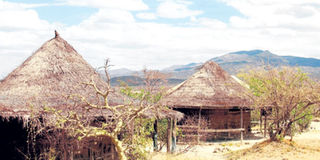Olorgesailie: Silent ‘place of the spirits’

For a quiet, interesting and inexpensive, wilderness weekend away, this prehistoric site is a good place to visit. PHOTO| JOHN FOX
What you need to know:
The day we were there, we saw a pale chanting goshawk and listened to its repeated mewing call. The social weavers are living up their name — sharing nests and choosing to live close to the bandas.
It can get very hot at Olorgesailie. If you are staying over, in the early morning or late afternoon it’s worth taking a longer walk past the excavations and down to the dunga, the dried river bed.
Would you like to hear the sound of silence? For real? Well, you can if you spend a night at Olorgesailie, the prehistoric site along the road to Magadi.
It must be about 20 years ago that we camped there. “You will hear the sound of silence,” a friend said. He was right. I woke in the middle of the night. I listened, and I could hear nothing — nothing at all. Normally, even in a tent in the bush, you can hear something — even if it’s just the wind gently rustling the leaves of a tree. But that night at Olorgesailie, there was nothing, nothing at all.
And I remembered that I had been told that its name means, “the place of the spirits.” If so, then that night they were keeping a deathly quiet.
We were there again a couple of weeks ago. We intended just a pop-in visit, because we were on our way for a picnic lunch at Lake Magadi. But, after Olepolos, the road was so badly potholed that we were driving at about 20kph, so it was mid-day before we reached Olorgesailie.
(That road used to be very well maintained by the Magadi Soda Company, but there have been changes in ownership, and I don’t know if that agreement still holds.)
Anyway, the Olorgesailie Prehistoric Site is an interesting place for a picnic, a walk, an overnight stay, and a well-presented dose of archaeological education. In fact, it’s best to start at the small museum — an outreach of the National Museums of Kenya. From its photographs, explanatory texts, a selection of excavated artefacts and other displays, you can get a good idea of the layout of the site, its geological and human history, and the significance of what has been found there in a series of archaeological excavations.
The site is 60-plus kilometres from the city and between two extinct volcanoes: Mt Olorgesailie and Mt Oldonyo Esakut. It was once a lake — between 200,000 and 100,000 years ago. And people who lived by the lake were of the “hand axe culture”. The evidence for this is the highest concentration of hand axes anywhere in the world.
Luke, an experienced guide employed at the site, took us round the many pathways and boardwalks. He showed us a place that seems to have been where wild animals were butchered — given the large number of stone axes, round stone hammers, and bone fragments found there. The bones are from animals such as extinct forms of hippo, elephant, zebra, giraffe, and baboon. The most impressive of them is the fossilised leg bone of a giant elephant, the great size of which has been emphasised by arranging it alongside the leg bone of a today’s elephant.
But the most prized exhibit is the partial hominid skull — a small, adult homo erectus — found at the same level as the hand axes.
There is much more to Olorgesailie than chipped stones, bones and pre-historic skulls. There is a stark beauty about the place, with its acacia trees surviving in the volcanic soils. In the distance there are the two misty blue mountains. And there are many birds.
The day we were there, we saw a pale chanting goshawk and listened to its repeated mewing call. The social weavers are living up their name — sharing nests and choosing to live close to the bandas.
It can get very hot at Olorgesailie. If you are staying over, in the early morning or late afternoon it’s worth taking a longer walk past the excavations and down to the dunga, the dried river bed.
Down there you could well see duikers, giraffes and elands. If you are very lucky you might also catch a glimpse of a long-necked gerenuk, because Olorgesailie is the westernmost extent of its range in southern Kenya.
For staying over, there are a few round and thatched self-service bandas. The four newer and smarter ones have twin beds, bedding, nets and kerosene lamps; the four older and not-so-smart ones have beds and bedding only. Outside — but not too far away — are blocks with warm (not hot) showers and long-drop toilets. There are also a couple of more “modern”, sit-down toilets for daytime visitors.
You can buy bundles of firewood from Masai women, who also sell beaded necklaces and other trinkets. You can find other more basic supplies at the dukas down the road at Oltepesi.
For a quiet, interesting and inexpensive, wilderness weekend away — despite the awful road — Olorgesailie is a good place to go.
The writer is managing director, iDC





